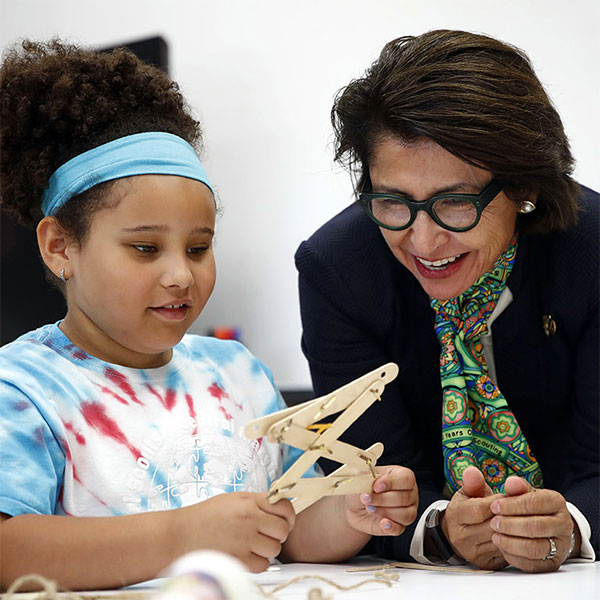The journey of a rocket scientist is 'advised' not to go to college
Sylvia Acevedo grew up on a dirty street in New Mexico state, USA. My grandparents, parents are immigrants and their lives have gone through a period of worrying that day or that day, extremely difficult.
Because the epidemic of meningitis in the Las Cruces region caused Sylvia Acevedo's sister to almost die, the whole family decided to move to another place.
At the new school, Sylvia Acevedo hears the advice of her classmate to join a life skills support organization and foster Brownie science love for 2nd and 3rd graders.
Later, when I was in my 60s, remembering this decision, Sylvia Acevedo realized that her life had turned away from that time.
For the first time, little girl Sylvia Acevedo knew the mysterious and mysterious world of the stars during a group trip. " I didn't know there were other planets - Mrs. Acevedo later recalled in an interview with NPR Radio - I didn't know there were constellations in the sky."

Sylvia Acevedo helps a young child to join the Girl Scouts Organization, the way to install a robot arm - (Photo: AP).
Then, with the encouragement of the team leader, the star-studded little girl tried to win a science badge at a life-support organization with the assembly of an Estes missile model. That memorable memory was later shared by her in the new memoir called Path to the Stars.
In the book, she talked a lot about perseverance and perseverance. It all comes from personal experience. While in high school, Sylvia Acevedo dreamed of studying at Stanford University. But when sharing that dream with an on-campus counselor, this person told Sylvia Acevedo to be "like you" girls, meaning girls of Spanish descent, not to go to college. But then she defied that.
When she got her first job as a field engineer while being a student at New Mexico State University, her workplace did not have women's restrooms. Despite all, Sylvia Acevedo eventually graduated from the University, then earned a master's degree in industrial engineering at Stanford University.
"Don't let anyone stop you in words. Don't let someone say you don't belong. Don't allow anyone to do it. Becoming a rocket scientist is my dream, but everyone has a dream. their wish " - she shared when she recalled the one-time celebration.
If someone does not believe in the special conditions, Sylvia Acevedo's life story is really convincing evidence. If, in her youth, a life-support organization was a turning point in her life, then she would return to the organization at the age of 60, but in another position, executive director of the team. Dedicated to girls (Girl Scouts), with the dream of helping them to realize their dreams and fulfill their dreams.
She took this position in 2016 after more than two decades working at major technology firms, holding technical and sales positions at companies such as NASA, IBM, Apple, Dell and Autodesk.
Her mission now doubles: strengthening the number of members and fostering a passion for science, technology and technology (STEM) for about 1.8 million girls and teenagers. Non-profit organization Girls Scouts.
Having lived through a time when women were not given equal opportunities, Sylvia Acevedo had her own views when she said that she should only focus on teaching girls. According to her, it is safer for them to be in a female environment.
"Girls will be excellent in environments where only female friends like Girl Scouts can fail because they can try something until they learn it. You can't do that in the environment. but teachers tend to favor boys first and girls are left aside, ' she said.
"The world is being rewritten with algorithms and coding. We need to have girls and women with these skills to create that future - Ms. Sylvia Acevedo shared with Forbes magazine - We want to make sure that the US workforce has a fairer division with women who can help us compete globally. "
Allowed to try and fail
More than anyone, Sylvia Acevedo understands the value of being allowed, encouraged, to try and fail. Acevedo's first rocket-patterned paper design took her to work at the US Aeronautics and Space Agency (NASA), but at first it could not launch off the ground.
Persistently pursuing research, she learned about the gravity of gravity and how to break it and was hypnotized with physical knowledge to launch a missile."At that moment, I realized that I could not only do science, I also loved science" - she shared.
- 'Scientist' flies with the rocket to prove ... The earth is flat
- The rocket takes the egg to the sky
- How are the names of University and College different?
- There is an extremely young scientist
- Humans will
- University students surpass NASA, successfully launching missiles with 100% 3D printing engines
- NASA scientist declared
- The most difficult tests in the world
- Video: Explain rocket science with 1,000 common English words
- What happens inside the rocket when taking off?
- Rocket crocodile - the largest freshwater fish in North America
- SpaceX is about to launch the world's most powerful rocket
 The most famous scientific failures in history
The most famous scientific failures in history Mysterious genius mechanic and the machine froze time
Mysterious genius mechanic and the machine froze time The son carries the 'bad gene' of genius Albert Einstein
The son carries the 'bad gene' of genius Albert Einstein Isaac Newton
Isaac Newton